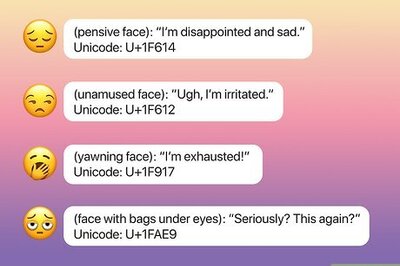
views
Fort Myers: Hurricane Irma's northern edge crashed into the Florida Keys on Sunday, bringing a double barrel threat of destructive winds and life-threatening storm surges that sparked one of the largest evacuations in US history.
The storm, which hammered Cuba's northern coast a day earlier, was a Category 4 hurricane about 15 miles (25 km) south-southeast of Key West, Florida, as of 7 am EDT (16:30 IST) with maximum sustained winds of 130 mph (210 kph), the National Hurricane Center said.
It was on a path that would take it along the state's Gulf of Mexico coast near population centers including Tampa and St. Petersburg, the NHC said. Hundreds of thousands of people spent the night in emergency shelters.
Storm surges pushed by a high tide were forecast to be as high as 15 feet (4.6 meters) for low-lying area along the state's southwest coast on Sunday, which could produce catastrophic flooding for thousands of homes.
“Take action now to protect your life,” the National Weather Service in Key West advised. "This is an extremely dangerous and life-threatening situation."
Officials in Florida have ordered a total of 6.3 million people, or about a third of the state's population, to evacuate, creating massive traffic jams on highways and overcrowding shelters.
Irma, which killed at least 22 people in the Caribbean, was likely to cause billions of dollars in damage to the third-most-populous US state.
Wind gusts near hurricane force began to batter the Florida Keys late on Saturday, the NHC said, with Key West seeing gusts of more than 80 mph on Sunday morning and water levels about 2 feet (61 cms) above normal.
SEEKING SHELTER
The NHC has put out a hurricane warning and a tropical storm warning stretching through almost all of Florida into Georgia and South Carolina - an area where more than 20 million people live.
Florida Power & Light said more than 430,000 customers in Florida were without power as of Sunday morning.
Irma comes just days after Hurricane Harvey dumped record-setting rain in Texas, causing unprecedented flooding, killing at least 60 people and leaving an estimated $180 billion in property damage in its wake. Almost three months remain in the Atlantic hurricane season, which runs through November.
Tracking models showed Irma would make landfall on the Keys and head along Florida's west coast, slamming the state that is a major tourism hub, with an economy comprising about 5 percent of U.S. gross domestic product.
Amid urgent warnings from state officials to evacuate before it was too late, downtown Miami was all but abandoned on Saturday.
On Florida's west coast, resident Charley Ball said he expected a storm surge to completely engulf the island of Sanibel where he lives.
"Just left the island and said goodbye to everything I own," said Ball, 62.
In Cuba, the destruction along the north central coast was similar to that suffered by other Caribbean islands over the last week as Irma plowed into Ciego de Avila province.
It was the first time the eye of a Category 5 storm had made landfall in Cuba since 1932, state media said, and the island's Communist government ordered the evacuation of more than a million people from its path.




















Comments
0 comment